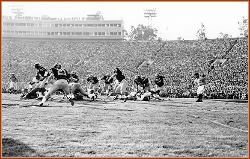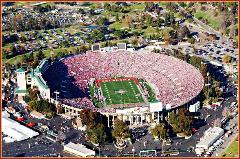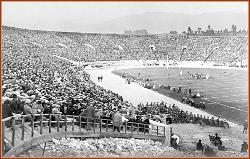



Home of Tulsa Football
Date Opened Oct. 4, 1930
Capacity 35,542
Record 285-133-14
Turf: Fieldturf (artificial), installed summer 2000
For over seventy years, Skelly Field at H.A. Chapman Stadium has been the home field for University of Tulsa football.
Opening Chapman Stadium was a dream come true for Coach Elmer "Gloomy Gus" Henderson. An unprecendented wave of prosperity swept
over America in 1928 and wealthy Tulsa oil men began listening to Henderson's dream. The trustees were proceeding with plans for a stadium on
faith that a donor would appear. In April, 1930, William Skelly, a long-time friend of the University, gave $125,000 to the stadium fund if another
$150,000 could be raised. The remaining money was raised by Tulsa businessmen who organized the Stadium Corporation of Tulsa.
Ground-breaking ceremonies were held on May 11, 1930 and the build-ing race was on to complete the stadium for the upcoming season.
Skelly Field opened on October 4, 1930 against Arkansas. Although it had a seating capacity of 14,500, records show that 13,000 spectators
were on hand for the game.
On the opening kickoff, Arkansas fumbled and end Johnny Potts recovered for Tulsa. On the first play from scrimmage Billy Boehm scored the
first touchdown in the north end zone of the stadium. Later, Chet Benefiel scored the the first touch-down in the south end zone. Tulsa went on to
win the contest by a score of 26-6.
Since that day, some of college football's greatest stars have graced the Skelly Field. Opponents the likes of Sammy Baugh, Ollie Matson, Bob
Fenimore, Walt Garrison, Gino Toretta and Keith Jackson are a few of the games' greatest to step on the Chapman Stadium turf. Tulsa's own
Glenn Dobbs in the 1940s, the passing Twilley in the 1960s, reknown receivers Steve Largent and Drew Pearson in the 70s, the 1980s Palomino
Express of Micheal Gunter and Ken Lacy and the stars from the 1991 Freedom Bowl Championship team thrilled Hurricane fans through the
years. The 2003 Humanitarian Bowl team excited fans by avergaing over 37 points in six home games.
1930
Groundbreaking ceremony for the 14,500 seat Skelly Field occurred on May 11. The first football game was played on Oct. 4, 1930 in front of a
crowd of 13,000. Tulsa defeated Arkansas 26-6.
1938
TU traded Skelly Field to the Tulsa Public Schools for the Philtower Building lot at 5th and Boston. TU began to lease the stadium from the board
of education.
1947
Lease renewal for Skelly Field was signed. The 5,000 seat north end zone stands were added and the scoreboard moved to the south end zone.
Skelly Field was the original name, but changed to Skelly Stadium when the north end zone seats were added.
1953
In August, former TU star Jim Finks played for the Pittsburgh Steelers in an exhibition game against the Chicago Bears before a crowd of 10,000.
1956
On June 18, Evangelist Reverand Billy Graham held a one-night rally and set what was to that date a stadium record crowd of 28,000.
1960
Newly formed American Football League entries, Houston Oilers and Dallas Texans, met in an exhibition contest in August.
1964
The stadium corporation was reorganized and it planned to build two high school stadiums (LaFortune and McLain) in exchange for Skelly
Stadium.
1965
Skelly Stadium was enlarged to 40,235 seats at a cost of $1,250,000. The track was removed, the field lowered and box seats added. The
excavated dirt was used to support the new south end zone stands. Seating was added to the west stands plus a new two story press box,
escalator and elevator. Work was completed in August.
1966
The third story photo deck was added to the press box. Skelly Stadium turned into a baseball field for one game on May 5. The St. Louis
Cardinals baseball club played their triple-A farm team, the Tulsa Oilers, in an exhibition game. The contest drew a crowd of 18,904, which saw
the Cards beat Tulsa 5-4.
1968
Skelly Stadium was returned to the University.
1972
Tartan turf was installed in the summer months
1977
Professional soccer made its debut at Skelly Stadium with a preseason game.
1978
The Tulsa Roughnecks, an NASL professional soccer team, moved into Skelly Stadium.
1979
Getty Oil Company and Getty Refining and Marketing Company made a $350,000 grant for refurbishing and repairs to the Stadium
1980
A modern scoreboard and animated message center was installed above the south stands. The sign package was donated by Dr. Pepper, KJRH
Television and Getty Refining and Marketing Company. The largest crowd for soccer occurred on April 26 when the Roughnecks met the New
York Cosmos before 30,831 fans.
1987
The largest crowd in Skelly Stadium history, 47,350, saw Tulsa lose to the nation's number one-ranked Oklahoma Sooners, 65-0.
1982
A new artificial turf was installed and the lighting system was replaced.
1984
A new scoreboard above the north end zone and 25-second clocks were added in each end zone.
1991
Stadia Turf, a new artificial surface, was installed in the summer. The football season had the highest season attendance average in school
history with an average of 31,236 fans for seven home games.
1993
A new scoreboard was erected in the south end zone. It was completed just one day before the home opener on September 18.
2000
New FieldTurf was installed in the summer. The synthetic artificial turf looks and feels like natural grass. The visiting team lockerroom was
renovated and the underbelly of the stadium underwent refurbishing.
2003
Installed new stadium lighting
2005
The North end zone stands were demolished in February,, thus clearing the way for the new Case Athletic Complex. The stadium seating was
reduced from 40,385 to 35,542.
2007
Skelly Stadium was changed to Skelly Field at H.A. Chapman Stadium.






